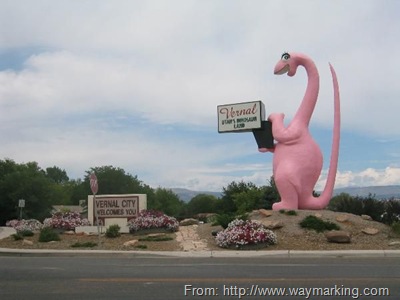26 May 1984
Dinosaur National Monument is the legacy of rivers past and present. Here, preserved in the sands of an ancient river, is a time capsule from the world of dinosaurs. The monument spans 200,000 acres (800 km sq) in Utah and Colorado. Our visit took us to to the Douglass Quarry, named for the paleontologist who discovered the fossil beds in 1909.

Dinosaur NM Map with the Douglass Quarry area circled.
[scanned from the national park Service Brochure]
Here’s a bit of information I noted in my photo album (sorry; I neglected to indicate the source):
The Age of Dinosaurs is but a very brief chapter in a long story, and only a paragraph about the dinosaurs themselves is written in the rocks here. Approximately 145 million years ago, about midpoint in dinosaur history, a suitable habitat for dinosaurs developed here. It became the home of dinosaurs such as Diplodocus, Stegosaurus, other vegetarians, and carnivores as well. As these animals lived and died, most of their skeletons decayed without a trace, but in at least one spot, river floodwaters washed a great number of carcasses and bones onto a sandbar. This layer itself was not very thick, but sediments piled on top of it as the sea fluctuated.

The dinosaur wall within the quarry building is a steeply tilted (67° from horizontal)
rock layer, which contains hundreds of dinosaur fossils.
[scanned from the cover of Dinosaur … The story behind the scenery]
When the Rocky Mountains began to rise to the east, this area was squeezed from the sides, sometimes cracking and shifting along fault lines. Rain, frost, wind, and gravity slowly wore away the uppermost strata, exposing the older rocks beneath.
Though many explorers preceded him, it was Earl Douglass, a paleontologist from Carnegie Museum in Pennsylvania, who first took a close look at what was weathering on the surface of the rocks. On August 17, 1909, he wrote in his diary: “At last in the top ledge … I saw eight of the tail bones of a Brontosaurus in exact position. It was a beautiful sight.” The quarry was designated a national monument in 1915.
[scanned from Dinosaur … The story behind the scenery]

Welcome to Dinosaur National Monument.
No dinosaurs were harmed on our hunting trip!

I’d like to think that these are the “eight of the tail bones of a Brontosaurus”
that Douglass discovered.

diamonds in the rough
skull and approx. two dozen bones of a Camarasaurus Lentus.
Left: Compared to the thigh bone of an Apotasaurus,
the Diplodocus had a slightly more slender thigh bone.
Right: We’re knee-high to these giants — thigh bone of a Diplodocus.

A rare specimen – reproduction of a juvenile Stegosaurus.
One of two in the world, this is the more complete of the two specimens.
The Douglass Quarry Exhibit Hall, which was closed in 2006 due to concerns over the instability of the building, is scheduled to open in October 2011. That’s good news since this is a place we most definitely want to return to someday.

























